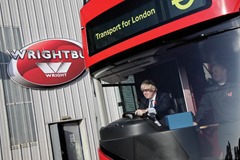Ballymena: an industrial track record
 agendaNi assesses the reasons for the town’s strong economic performance and the current shape of its workforce.
agendaNi assesses the reasons for the town’s strong economic performance and the current shape of its workforce.
Ballymena was initially a market town, prospering on some of the best grazing land in the province. Food processing also has a long history, manifested today in the O’Kane Poultry and RJ Cherry & Son plants.
The fast-flowing River Braid was ideal for linen production and the industry later diversified into rayon. Engineering also took off after the Second World War, with the formation of Robert Wright Coachworks Ltd in 1946. His son, William, saw a niche in commercial body-building and it was already employing over 50 people by the 1960s. The first small buses were built in the next decade and a major expansion has followed since then; the company now employs 1,400 people.
While best known for the new Routemaster in London, Wrightbus also has a manufacturing facility in Singapore and customers in the USA, Singapore, Hong Kong, Australia, Holland and the Middle East.
Michelin’s Ballymena factory produced its first tyre on 3 December 1969. Most of its output is exported, mainly to North America, and the plant provides 1,100 jobs.
Tobacco manufacturer Gallahers employs around 600 people. Owned by Japan Tobacco International since 2007, Gallahers is the company behind the Benson & Hedges, Camel and Silk Cut brands, and holds 39 per cent of the UK market.
The reasons for economic success are sometimes hard to pin down. In Ballymena’s case, there was an existing industrial base (textiles) which grew through local entrepreneurship and multi-national investment.
Ballymena was also designated as a ‘new town’ in the 1960s and therefore attracted extra support from government. Anecdotal evidence suggests that retail in Ballymena, along with other town centres, was sustained during the Troubles as shoppers were often reluctant to go into Belfast.
In terms of skills and education, Ballymena Academy principal Ronnie Hassard has highlighted strong parental support for schools and high expectations. Its post-primary schools regularly produce good GCSE and A-level results but, as with other parts of Northern Ireland, many talented school leavers migrate to Great Britain.
The 2011 Census recorded the qualifications of people aged over 16 i.e. the school leaving age. In Ballymena, it found that 22 per cent of that population had a degree or a higher qualification, just below the 23.6 per cent regional average. However, there is no room for complacency as the share of adults with no qualifications (31.5 per cent) was slightly higher than across Northern Ireland (29.1 per cent).
In the more recent labour market statistics, for 2012, Ballymena had an above average economic activity rate (76.1 per cent) and employment rate (71.7 per cent). A manufacturing base adds real economic value but manufacturing is also more sensitive to energy prices, given its higher usage.
Going forward, Ballymena’s business-people are hoping to attract more tourism. Many visitors pass by on their way to the North Coast.
Separately, the Northern Ireland Science Industry Panel identified five growth areas in its 2008 Matrix report: pharmaceuticals, life sciences, ICT, agri-food, advanced engineering and advanced materials. Ballymena has performed very well in agri-food and engineering but the report indicates that it could improve its prosperity by diversifying in the other key sectors.





